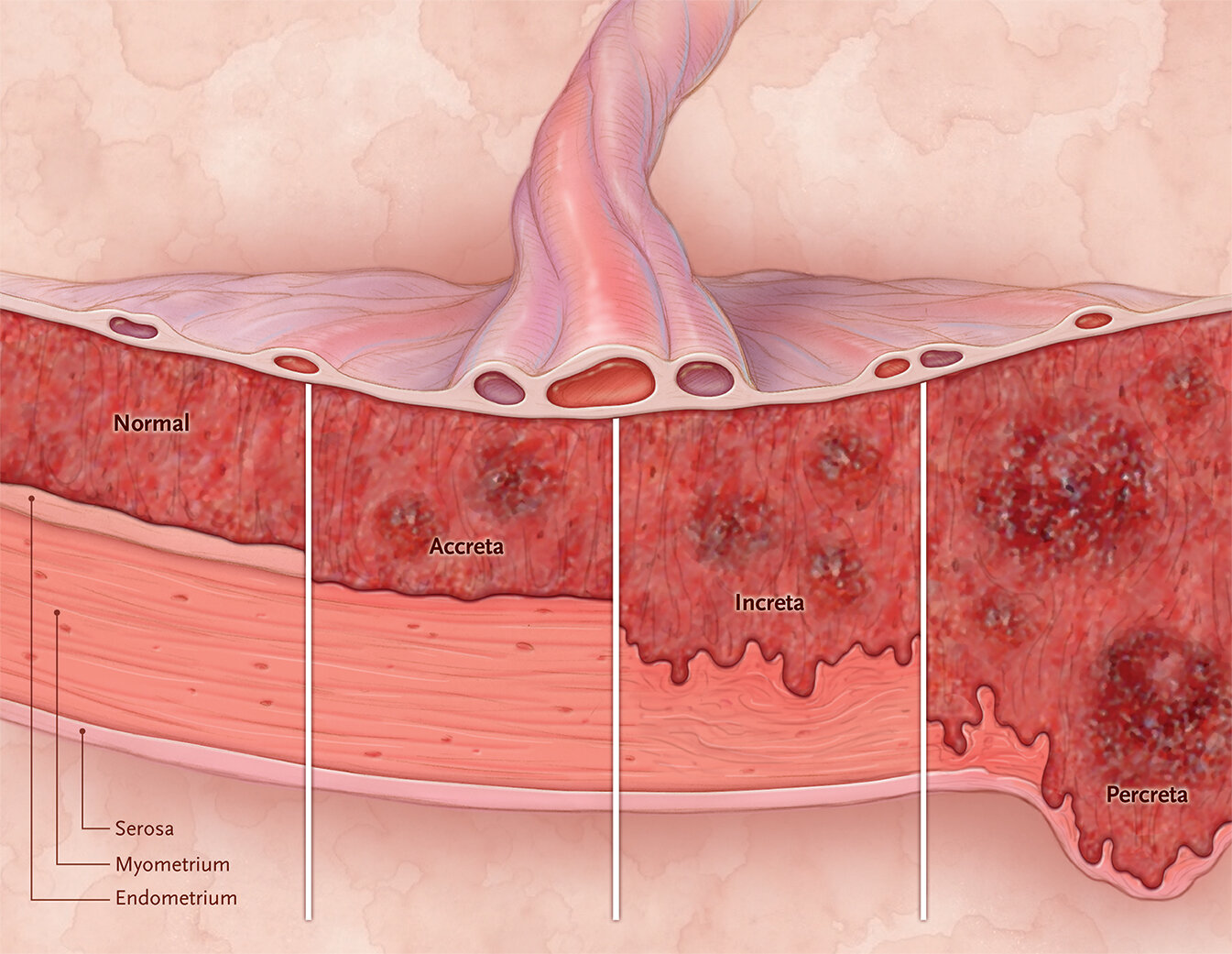Induction & Cervical Ripening Methods
/Background / Context for Labor Induction
Labor induction is becoming all the more common!
CDC data shows that as of 2018, over 27% of labor in the USA is induced, representing an over 2-fold increase since 1990.
While the effects of the ARRIVE trial and similar studies are still playing out, it’s reasonable to think that rates of induction may only continue to rise.
Reasons for labor induction are varied and significant. ACOG CO 818 is a great resource to review many common reasons for induction prior to 39 weeks.
Bishop Scoring
The Bishop score was developed by Dr. Edward Bishop, published in the Green Journal in August 1964. The score used a combination of five physical examination criteria to predict the success of induction of labor:
Cervical dilation
Cervical effacement
Fetal station with respect to the ischial spines
The position of the cervix (posterior/mid/anterior)
The consistency of the cervix (firm/medium/soft)
The first three components, dilation, effacement, and station, are known as the “modified Bishop score.”
In multiparous patients, a score of 6 or greater portends favorability with labor induction with oxytocin.
In nulliparous patients, a score of 8 or greater portends favorability.
If the score is less than these, the recommendation is to pursue cervical ripening prior to augmenting labor with oxytocin.
Cervical Ripening: How the Cervix Works!
Obviously, cervical remodeling is a HUGE part of labor. It has to completely reshape to get the baby out! This takes the form of:
Collagen breakdown and rearrangement
Changes in the glycosaminoglycan and cytokine environment
Infiltration of leukocytes.
These changes occur with numerous local signaling pathways which cause local release of prostaglandins at the level of the cervix, as well as ultimately the central hormonal signaling pathway to begin oxytocin release from the posterior pituitary gland.
Cervical Ripening
When the cervix isn’t ready to dilate, as is the case with labor induction or even with procedures for pregnancy termination or demise management such as D&E, these methods improve success and reduce complications.
Mechanical methods use a combination of local action to physically cause cervical dilation, as well as release local endogenous prostaglandins to promote cervical dilation.
Pharmacologic methods use synthetic prostaglandins or oxytocin to cause a direct pharmacologic effect on the uterus/cervix.
Mechanical Methods of Cervical Ripening
Foley Balloons
This is probably the most common and well-tolerated form of mechanical cervical ripening.
In essence, a Foley balloon can be placed into the cervix behind the internal cervical os, and filled with 20-80cc of saline.
This “tricks” the cervix into believing there’s a well-engaged fetal head, which promotes pure mechanical dilation just from pressure of the balloon on the cervix, as well as localized prostaglandin release.
Some “double balloon” devices exist, which have a second balloon acting at the external os that may help promote cervical dilation/prostaglandin release further.
There are relatively few contraindications to the Foley ballon.
Unlike pharmacologic methods, it is not associated with tachysystole or fetal heart rate abnormalities. It can also be removed easily if there is an adverse reaction.
An absolute contraindication might be latex allergy, if you use a balloon that contains latex.
Relative contraindications include:
Low-lying placenta, where the balloon contacting the placenta may cause vaginal bleeding.
Ruptured membranes: while data is mixed on this, there is thought that placing a balloon after membrane rupture may increase risk of chorioamnionitis.
Variable/unstable fetal lie: putting a balloon in the cervix may displace the fetal head, so have a low threshold to re-scan for presentation if you suspect the baby may have floated away!
Mechanical dilators: Laminaria and Dilapan
These mechanical dilators could also be considered, and in philosophy are very similar to Foley balloons in how they promote cervical ripening.
Laminaria, a sterilized seaweed hygroscopic dilator, has fallen out of favor for term labor induction in most centers due to studies demonstrating increased risk of infection.
However, laminaria is still routinely used safely for cervical ripening prior to D&E procedures.
Dilapan (a synthetic hygroscopic dilator) has been examined in an RCT for labor induction and has been found to be safe and acceptable for patients
In most places, its expense is a barrier to use versus the Foley.
Amniotomy & Membrane Stripping
Membrane stripping is a technique in which an examiner uses the gloved finger to “stir” the membranes at the internal cervical os. This promotes localized prostaglandin release and can be used to help ripen the cervix in a “natural” and low risk way.
Complications of this can include bleeding, contractions, and inadvertent amniotomy, but overall it’s a low risk procedure that can be considered in most low-risk women at term.
Amniotomy, or as it’s better known on the labor floor -- AROM / artificial rupture of membranes -- is when an examiner breaks the amniotic sac using a tool such as a plastic hook.
This allows for descent of the fetal head to the cervix (engagement) to promote physical cervical dilation, as well as likely some localized prostaglandin release.
Amniotomy alone is likely not appropriate for ripening/labor induction.
Most commonly, it is used in combination with pharmacologic methods, and it seems to be very effective in this context -- most studies demonstrate a shorter intervention-to-delivery time of combination medicine/amniotomy method versus only one of these alone.
The most feared complication of amniotomy is cord prolapse, in which the umbilical cord prolapses in front of the fetal head into the vagina. This requires emergent cesarean delivery, as further descent of the fetal head may compress the cord and cause asphyxia.
Rates of cord prolapse with amniotomy are low though, with rates in the literature ranging from 0.1 - 0.7%.
Other complications/contraindications relate to infection, like chorioamnionitis, or fetal heart rate abnormalities related to fluid decrease/umbilical cord compression -- these are generally variable decelerations which can be corrected with amnioinfusion.
Given the break in the barrier between the fetus and the vaginal environment, early amniotomy is generally not recommended in patients with HIV or hepatitis B or C.
Pharmacologic Methods
Misoprostol & Other Prostaglandins
Misoprostol, aka PGE1, is a synthetic prostaglandin and can be administered in a variety of doses and routes - for labor induction/ripening, typically bucally, orally, or vaginally.
The majority of adverse outcomes noted in studies looking at term labor has been with doses over 25 mcg.
It is well tolerated, effective, and generally safe! However, some complications/risks:
Unlike oxytocin, which has a short half-life and is given IV, when misoprostol is given, it cannot be stopped or taken away (need to use a tocolytic)!
Institutions providing birth services should have protocols to monitor fetal heart rate patterns and for uterine tachysystole, and have strict time intervals for dosing for this reason. Misoprostol is potent and can definitely cause tachysystole and resulting fetal heart rate abnormalities.
Given the potency, misoprostol is absolutely contraindicated for patients who are induced and have a prior uterine scar (i.e., TOLAC), as there is an association with its use and uterine rupture (6% rupture rate in some studies!).
Misoprostol should also not be administered in the context of suspicious CTG/EFM, given its potency and inability to stop the medication quickly.
Additional side effects of misoprostol can include high fevers and GI upset, particularly when administered via the oral or buccal routes. This is likely due to higher absorption/systemic concentration by these routes.
PGE2, available as a vaginal insert containing 10mg of dinoprostone, commercially known as Cervidil. A vaginal dinoprostone gel (Prostin) was formerly in common use in the USA, but now is more commonly used internationally.
There is not a significant difference in how PGE2 works versus misoprostol for cervical ripening; however, one advantage is that the vaginal insert can be removed, and the half-life is shorter -- so unlike miso, the action can be stopped relatively easily.
PGE2 is likewise contraindicated in the context of TOLAC due to presumed increased uterine rupture risk.
Oxytocin
The OG! Oxytocin is the natural hormone from the posterior pituitary that promotes uterine contractions and labor. It can be used for cervical ripening as well in patients with unfavorable cervix, particularly for patients where prostaglandins may be contraindicated.
For instance with TOLACs, there is a slightly higher risk of uterine rupture with oxytocin (~2%).
However this is dose-dependent and lower risk compared to prostaglandins; thus some institutions will allow for oxytocin induction of TOLACs.
Institutions have different protocols for “low-dose” and “high-dose” oxytocin drips; studies vary in their description of the efficacy of one over another.
Oxytocin has specific uterine receptors, which promote intracellular calcium release in uterine muscle and also localized prostaglandin production. It has a positive feedback mechanism with the posterior pituitary during parturition, thus more oxytocin is produced/released over the course of childbirth.
Complications are fairly few with synthetic oxytocin, since it is so similar to our biologic form; however:
As a posterior pituitary hormone, oxytocin has similar chemical structure to anti-diuretic hormone (ADH). Thus, in large doses (particularly if infused fast and not on an IV pump), oxytocin can lead to fatal water intoxication / hyponatremia. It should always be run on a pump by specifically-trained nursing personnel!
Nipple stimulation is a way to cause endogenous oxytocin release, and may be favored by some patients for home “induction start” or cervical ripening.
It has only been studied in low-risk pregnancies, and generally seems to work better in patients with a favorable Bishop score already.
Nipple stimulation has also been associated with an increased trend in perinatal death, so ACOG does not recommend its use in an unmonitored setting until there is further study.
Which method is best?
That’s the million dollar question!
You can likely find literature to support your position.
Trials comparing labor induction methods are highly variable in their populations and outcome measures.
Even in outcome measures, what’s most valuable? C-section rate? Time from induction to delivery? Length of oxytocin use? Rates of infection or other complications? The literature is full of examples that have used each and every one of these, so comparisons are hard to make!
There are some likely general conclusions to take away:
Combination of mechanical and pharmacologic methods are likely faster to achieve delivery than mechanical methods alone.
If you’re concerned about fetal status or uterine tachysystole, misoprostol is probably not the best choice.
The patient in front of you is going to dictate what is best -- the indication for induction, the varying factors of the patient’s medical and pregnancy history, and your institution’s experience and personnel are all paramount to making induction successful!




